
SpaceX's massive Starship vehicle may start taking to the skies in earnest this summer.
Starship consists of a huge first-stage booster called Super Heavy and a 165-foot-tall (50 meters) upper-stage spacecraft known as Starship. SpaceX is developing the vehicle to take people and cargo to the moon, Mars and other destinations throughout the solar system.
The company has conducted a handful of high-altitude test flights with Starship upper-stage prototypes from Starbase, its South Texas site near the village of Boca Chica. And it's gearing up for the transportation system's first orbital test flight, which SpaceX founder and CEO Elon Musk now says could happen soon.
Photos: SpaceX lifts huge Super Heavy rocket onto launch stand
"Starship will be ready to fly next month. I was in the high bay & mega bay late last night reviewing progress," the billionaire entrepreneur said via Twitter today (June 14).
"We will have a second Starship stack ready to fly in August and then monthly thereafter," Musk added in another tweet today.
Much of this prep work involves building and testing Raptors, the next-generation engine that will power Starship. Each Super Heavy booster will sport 33 Raptors and each Starship spacecraft will have six of them, Musk has said.
Get the Space.com Newsletter
Breaking space news, the latest updates on rocket launches, skywatching events and more!
For perspective: SpaceX's workhorse Falcon 9 rocket is powered by nine less-powerful Merlin engines in its first stage and one in its upper stage.
Hardware readiness won't guarantee a July Starship flight, however; SpaceX still needs to secure a launch license from the U.S. Federal Aviation Administration (FAA). And getting one won't necessarily be easy; the FAA just issued an environmental assessment of Starship activities at Starbase, which laid out more than 75 things that SpaceX must do to mitigate its impact on the surrounding area, a biodiversity hotspot.
If everything goes well with Starship's test campaign, the vehicle could go very far afield in the next few years. NASA picked Starship to be the first crewed lunar lander for its Artemis program, which aims to put boots on the moon in 2025 or 2026. And Musk has voiced optimism that Starship could start launching people to Mars in the same general time frame, though he tends to set very aggressive targets for his companies.
Mike Wall is the author of "Out There" (Grand Central Publishing, 2018; illustrated by Karl Tate), a book about the search for alien life. Follow him on Twitter @michaeldwall. Follow us on Twitter @Spacedotcom or on Facebook.
Join our Space Forums to keep talking space on the latest missions, night sky and more! And if you have a news tip, correction or comment, let us know at: community@space.com.

Michael Wall is a Senior Space Writer with Space.com and joined the team in 2010. He primarily covers exoplanets, spaceflight and military space, but has been known to dabble in the space art beat. His book about the search for alien life, "Out There," was published on Nov. 13, 2018. Before becoming a science writer, Michael worked as a herpetologist and wildlife biologist. He has a Ph.D. in evolutionary biology from the University of Sydney, Australia, a bachelor's degree from the University of Arizona, and a graduate certificate in science writing from the University of California, Santa Cruz. To find out what his latest project is, you can follow Michael on Twitter.









